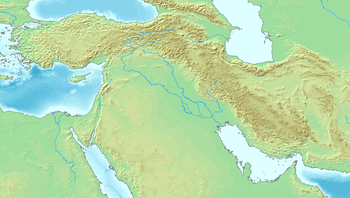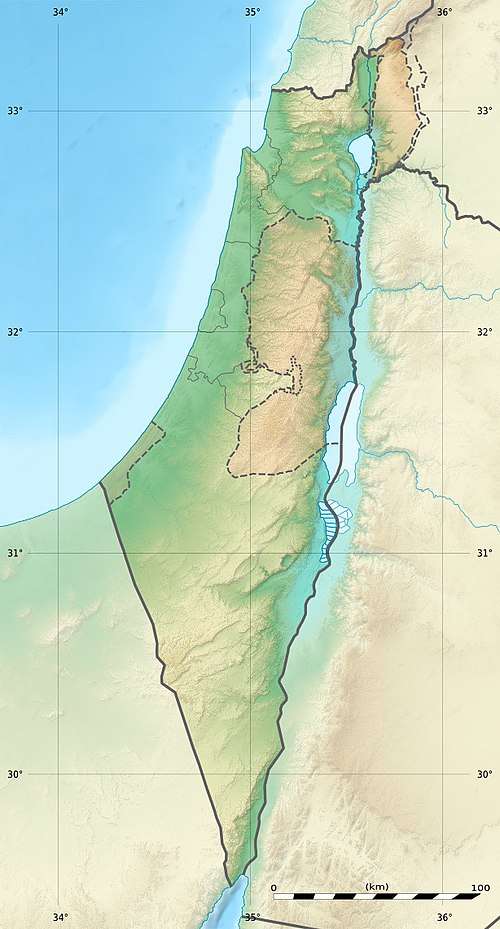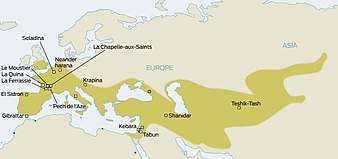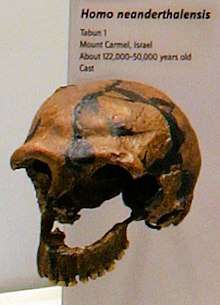Tabun Cave
The Tabun Cave is an excavated site located at Nahal Me'arot Nature Reserve, Israel and is one of Human Evolution sites at Mount Carmel, which were proclaimed as having universal value by UNESCO in 2012. The cave was occupied intermittently during the Lower and Middle Paleolithic (500,000 to around 40,000 years ago). In the course of this period, deposits of sand, silt and clay of up to 25 m (82 ft) accumulated in the cave. Excavations suggest that it features one of the longest sequences of human occupation in the Levant.
.jpg) Tabun Cave | |
 location in Israel  Tabun Cave (Israel) | |
| Location | Mount Carmel, Nahal Me'arot Nature Reserve |
|---|---|
| Region | Israel |
| Coordinates | 32°40′13.80″N 34°57′55.80″E |
| History | |
| Periods | Lower Paleolithic and Middle Paleolithic |
| Cultures | Mousterian |
| Associated with | Neanderthal |
| Site notes | |
| Excavation dates | 1929, 1967 |
| Archaeologists | Arthur Jelinek |

Deposits
The earliest and lowest deposits in the cave contain large amounts of sea sand. This, and pollen traces found, suggests a relatively warm climate at the time. The melting glaciers which covered large parts of the globe caused the sea level to rise and the Mediterranean coastline to recede. The Coastal Plain was then narrower than it is today, and was covered with savannah vegetation. The cave dwellers of that time used handaxes of flint or limestone for killing animals (gazelle, hippopotamus, rhinoceros and wild cattle which roamed the Coastal Plain) and for digging out plant roots. As tools improved slowly over time, the hand axes became smaller and better shaped, and scrapers made of thick flakes chipped off flint cores were probably used for scraping meat off bones and for processing animal skins.[1]
The upper levels in the Tabun Cave consist mainly of clay and silt, indicating that a colder, more humid climate prevailed as glaciers formed once more; this change yielded a wider coastal strip, covered by dense forests and swamps. The material remains from the upper strata of the cave are of the Mousterian culture (about 200,000 - 45,000 years ago). Small flint tools made of thin flakes predominate these levels, many produced using the Levallois technique. Tools typical of the Mousterian culture feature elongated points, and include flakes of various shapes used as scrapers, end scrapers and other denticulate tools used for cutting and sawing.
Arthur Jelinek's 1967 to 1972 excavations of the cave yielded over 1,900 complete and partial bifaces. The bulk of the biface assemblage can be attributed to the Late Acheulian and Yabrudian industries.[2]
The large number of fallow deer bones found in the upper layers of the Tabun Cave may be due to the chimney-like opening in the back of the cave which functioned as a natural trap. The animals may have been herded towards it, and fell into the cave where they were butchered.
The Tabun Cave contains a Neanderthal-type female, dated to about 120,000 years ago. It is one of the most ancient human skeletal remains found in Israel.[3][4] A 2014 study of objects at Tabun suggests that ancestral humans used fire at the site on a regular basis since about 350,000 years ago.[5]
Gallery
 Homo Neanderthalensis, Tabun 1, Mount Carmel, Israel About 120,000-50,000 BP (replica)
Homo Neanderthalensis, Tabun 1, Mount Carmel, Israel About 120,000-50,000 BP (replica) Five hand axes, excavated 1929-1934, British Museum
Five hand axes, excavated 1929-1934, British Museum.jpg) Production of points & spearheads from a flint stone core, Levallois technique, Mousterian culture, Tabun Cave, 250,000-50,000 BP
Production of points & spearheads from a flint stone core, Levallois technique, Mousterian culture, Tabun Cave, 250,000-50,000 BP
See also
- List of fossil sites
- List of hominina fossils
References
- Wills, Christopher (28 March 2013). Green Equilibrium: The Vital Balance of Humans and Nature - Christopher Wills. OUP Oxford. p. 147. ISBN 9780199645701. Retrieved 7 March 2017.
herding at Tabun Cave.
- "New excavations at the Tabun cave, Mount Carmel, Israel, 1967-1972 : A preliminary report - Persée". Persee.fr. Retrieved 7 March 2017.
- ANNE-MARIE TILLIER (2005). "The Tabun C1 Skeleton: A Levantine Neanderthal?". Mitekufat Haeven: Journal of the Israel Prehistoric Society / מתקופת האבן. ל"ה: 439–450. JSTOR 23383575.
- Coppa, A.; Grün, R.; Stringer, C.; Eggins, S.; Vargiu, R. (September 2005). "Newly recognized Pleistocene human teeth from Tabun Cave, Israel". Journal of Human Evolution. 49 (3): 301–15. doi:10.1016/j.jhevol.2005.04.005. ISSN 0047-2484. PMID 15964608.
- Nala Rogers (12 December 2014). "Israeli cave offers clues about when humans mastered fire". Sciencemag.org. Retrieved 7 March 2017.